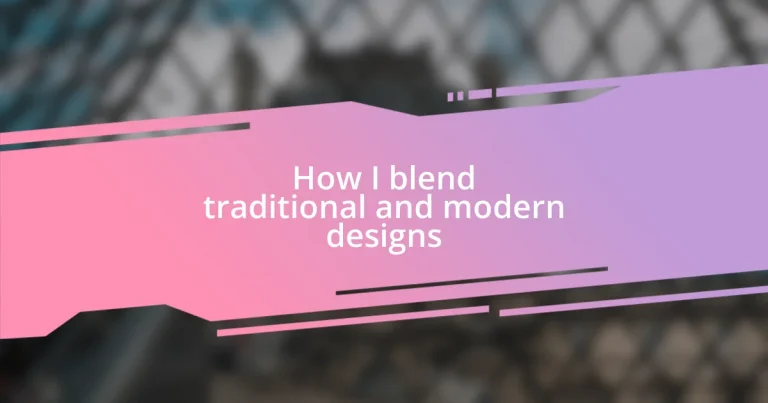Key takeaways:
- Traditional design emphasizes craftsmanship, balance, and functionality, which can be harmoniously integrated with modern aesthetics.
- Modern design trends focus on minimalism, biophilic design, sustainability, and smart technology, reflecting evolving lifestyles and values.
- Effective techniques for blending styles include layering textures, mindful color selection, and incorporating art, creating spaces that evoke emotion and narrative.
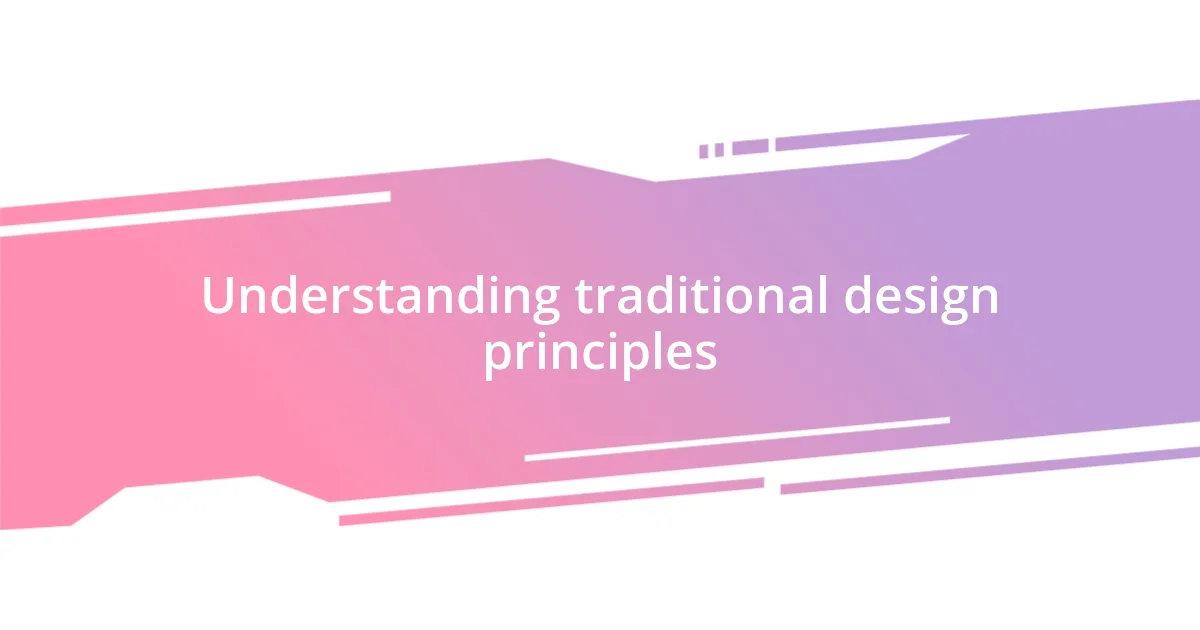
Understanding traditional design principles
Traditional design principles are rooted in historical context and cultural significance. I remember visiting a beautiful Victorian home that took my breath away; the intricate moldings and the symmetry of the rooms made it clear that every detail had a purpose and meaning. Isn’t it fascinating how these principles, like balance and harmony, continue to resonate in our work today?
When I delve into traditional design, I often reflect on the importance of craftsmanship. The quality of materials, the meticulous attention given to details, and the storytelling behind each piece are what make traditional design so rich. It makes me wonder—how can we honor these values while integrating modern aesthetics?
Traditionally, designs were not just about beauty; they also served functional purposes. For instance, consider how spaces were planned for social gatherings, emphasizing community and connection. I’ve seen how authentic traditional elements can inspire warmth and conversation in a modern setting. Doesn’t that blend make a space feel alive?

Exploring modern design trends
Modern design trends are ever-evolving and often reflect our changing lifestyles and values. I recall stepping into a friend’s newly remodeled apartment, where the infusion of modern touches—a sleek kitchen island paired with vintage-inspired lighting—created a delightful contrast that felt both timely and timeless. It struck me how designers today are favoring open spaces, natural light, and sustainable materials, signaling our desire for comfort coupled with environmental awareness.
Here are some prominent modern design trends I’ve noticed:
- Minimalism: Emphasizing simplicity and decluttering, focusing on essential elements.
- Biophilic Design: Integrating nature, such as plants and natural light, into interior spaces to enhance well-being.
- Sustainable Materials: Using recycled or eco-friendly materials to promote environmental consciousness.
- Smart Homes: Incorporating technology that enhances convenience and energy efficiency.
In my experience, blending these trends with traditional aesthetics can create spaces that feel both fresh and familiar, allowing us to connect with our history while embracing the future.
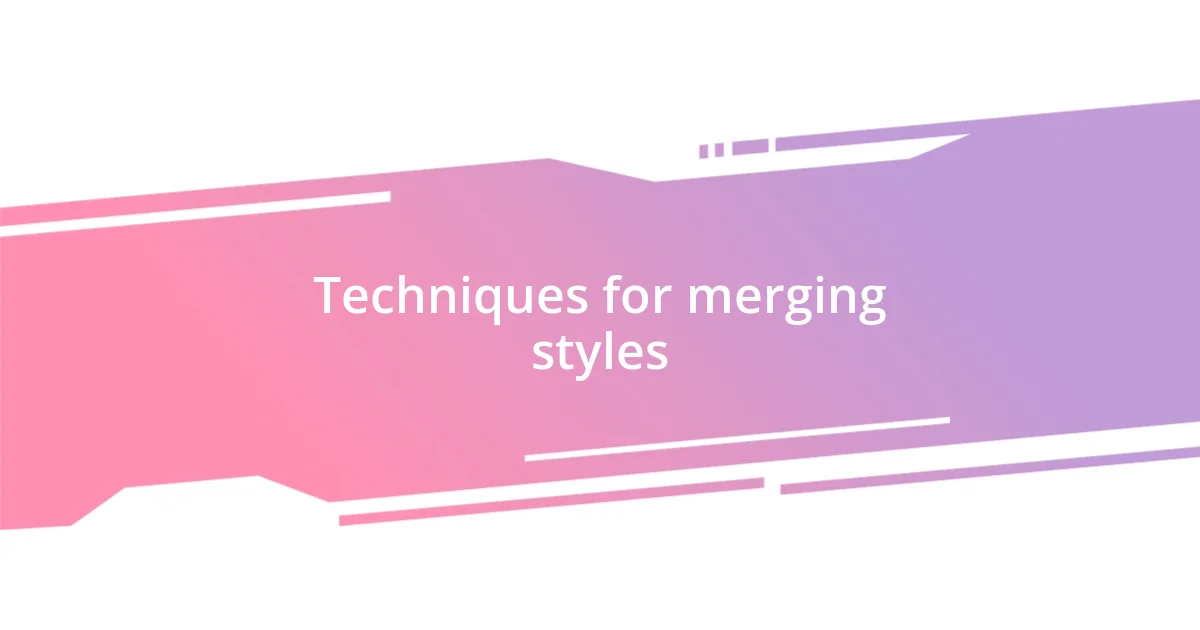
Techniques for merging styles
I enjoy exploring various techniques to merge traditional and modern designs in a way that feels authentic yet innovative. One method I find incredibly effective is layering textures. For example, I once decorated a cozy reading nook where I paired a classic leather armchair with a contemporary geometric throw blanket. The contrast not only added warmth but also sparked delightful conversations about style and comfort. The blend of the old and the new can evoke emotions and inviting spaces, making each design decision a story waiting to be shared.
Another technique I advocate for is the mindful selection of color palettes. I remember renovating my grandmother’s kitchen, where we retained the original cabinetry but introduced a fresh, soft color on the walls. This balance between the traditional woodwork and a modern hue revitalized the space without losing its historical charm. Choosing colors that complement both styles can create a harmonious environment that feels both past and present, affecting the mood and energy of the room.
Incorporating art and decor is also a stimulating way to unite these styles. I recall visiting a gallery that showcased modern art pieces alongside antique furniture. That juxtaposition made me ponder how well-selected art can serve as a bridge, joining different eras. For instance, hanging contemporary art prints in a room filled with traditional furniture can create a dialogue between styles, offering a refreshing take that captures the essence of both worlds.
| Technique | Description |
|---|---|
| Layering Textures | Combining different textures to create warmth and depth, such as pairing vintage and modern fabrics. |
| Mindful Color Selection | Using colors that work well with both traditional and modern elements to maintain balance and harmony. |
| Incorporating Art and Decor | Using artwork to link various design styles, creating a dialogue between traditional and modern aesthetics. |
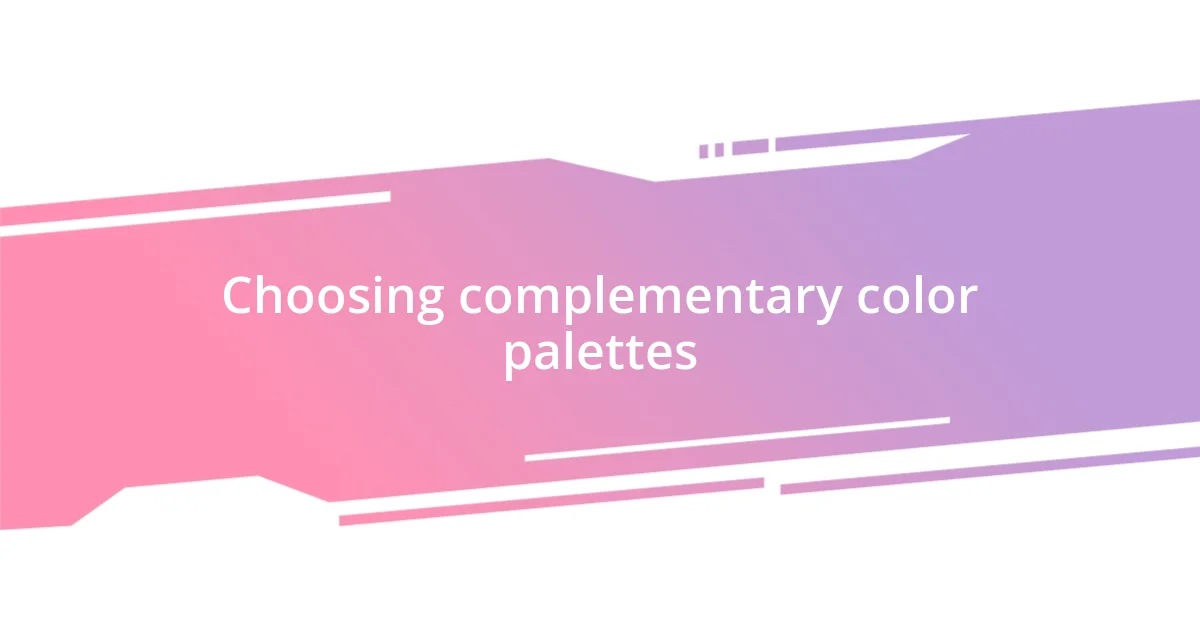
Choosing complementary color palettes
Choosing a color palette that harmonizes traditional and modern elements can be both an art and a science. I vividly remember a project where I had to select colors for a sleek modern dining room with a magnificent antique table. By opting for a soft sage green for the walls and pairing it with rich wooden tones, the room transformed into a serene space that felt welcoming yet contemporary. It begged the question: how can a simple color choice evoke such a strong sense of nostalgia while still feeling fresh?
In my opinion, neutrals can serve as a fantastic canvas. I once painted an office space in muted grays, which not only showcased the traditional wooden desk but also offered a modern backdrop for vibrant artwork. The subtle warmth of the grays allowed the pieces to pop, creating an inspiring workspace. Have you ever noticed how neutral palettes can pave the way for bold accents? It’s like giving room for your personality to shine through.
Finally, consider how colors interact with natural light. I experimented with a sunny yellow in a sunroom that was adorned with antique wicker furniture. The yellow infused the space with warmth and energy, making morning coffee feel like a delightful ritual. How can light and color elevate your daily experiences? I’ve learned that intentional color choices resonate emotionally, making everyday moments feel extraordinary.
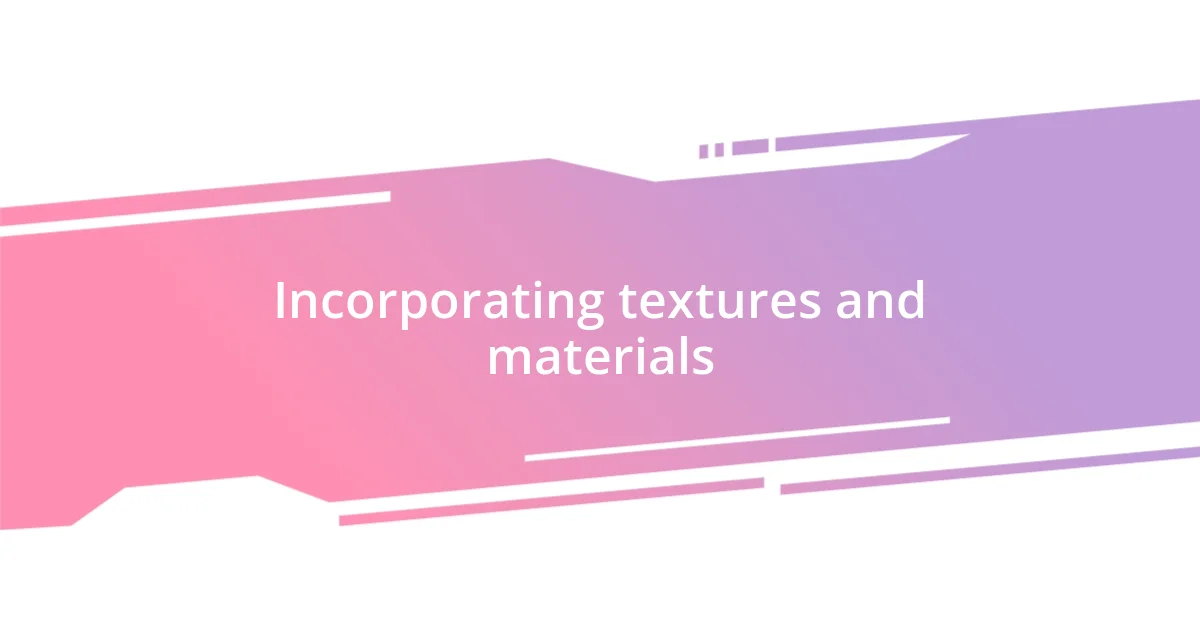
Incorporating textures and materials
Incorporating textures and materials plays a crucial role in bridging traditional and modern designs. One of my favorite experiences was revamping my living room, where I decided to mix a rustic reclaimed wood coffee table with sleek, metal side tables. The different materials not only created visual interest but also evoked a sense of history paired with a contemporary edge. Can you imagine the conversation starter that piece has become? It’s these tactile contrasts that invite touch and curiosity, engaging everyone who steps into the space.
I’ve also found that using textiles can significantly impact how textures harmonize within a design. For instance, I once draped a vintage lace tablecloth over a minimalist dining table. The intricate details of the lace brought warmth and character into the otherwise stark setting. This combination taught me how layering textiles creates a rich, sensory experience that stirs emotions and memories. What do you think makes a space feel cozy? I believe it’s often the textures we incorporate that spark those feelings of comfort and familiarity.
A pivotal aspect of my design philosophy is utilizing natural materials. I often select stone and wood for their warm, organic qualities. When constructing my outdoor patio, I chose smooth river stones as part of the hardscape alongside reclaimed wooden benches. The result was a harmonious blend that effortlessly connects the space to nature. Have you ever felt the grounding effect of natural elements? In my experience, incorporating such materials can ground a design, creating an oasis that feels beautifully alive and inviting.
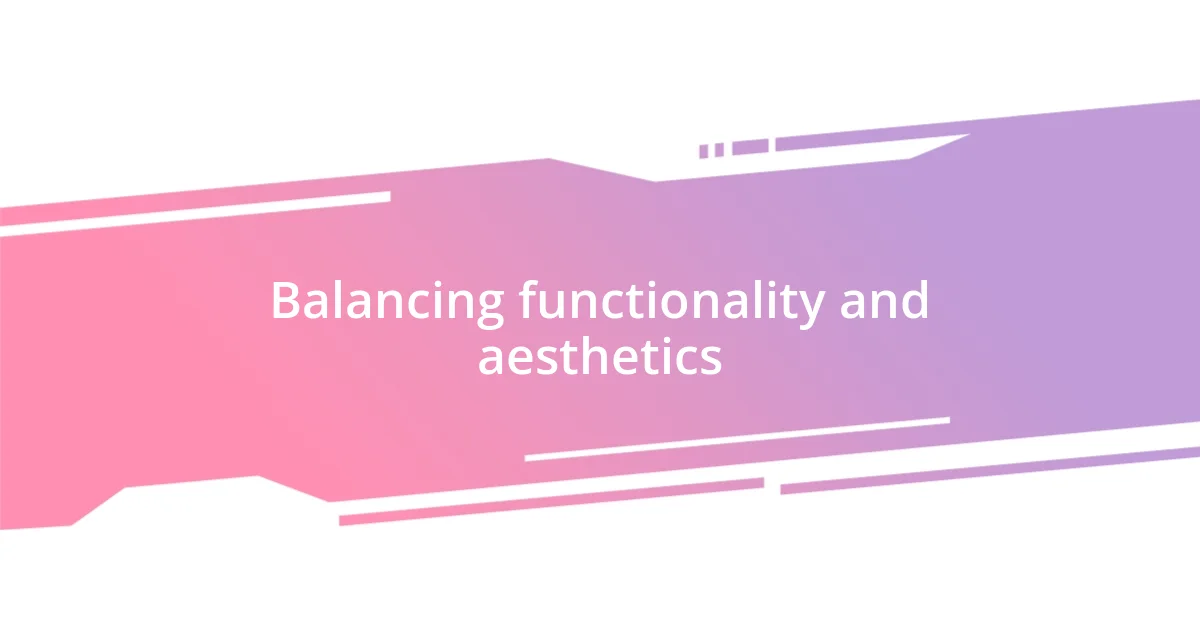
Balancing functionality and aesthetics
Balancing functionality and aesthetics is like finding the perfect rhythm in design. I remember tackling my kitchen renovation, where I wanted it to be both practical for cooking and inviting for gatherings. By opting for open shelving that showcased beautiful dishware alongside modern appliances, it became a space where function met heartfelt gatherings. Have you ever thought about how the way we arrange our kitchens can influence not only our cooking but also our social moments?
Another fascinating aspect I’ve discovered is how furniture placement can enhance both elements. For example, in my home office, I positioned a classic roll-top desk just beneath the window, allowing light to flood the space. This not only created a beautiful focal point but also encouraged productivity as I worked with nature’s backdrop. It’s intriguing how a single choice in placement can evoke creativity and calmness simultaneously, wouldn’t you agree?
Ultimately, the idea of merging these two aspects extends beyond aesthetics or functionality alone; it’s about creating an experience. I once curated a cozy reading nook that combined a modern chair with an antique side table adorned with family photos. It was a small space, yet it spoke volumes about warmth and usability. How do we curate our spaces to feel both beautiful and livable? In my experience, this balance is a dialogue—where each element speaks to the other, creating a narrative that feels uniquely ours.
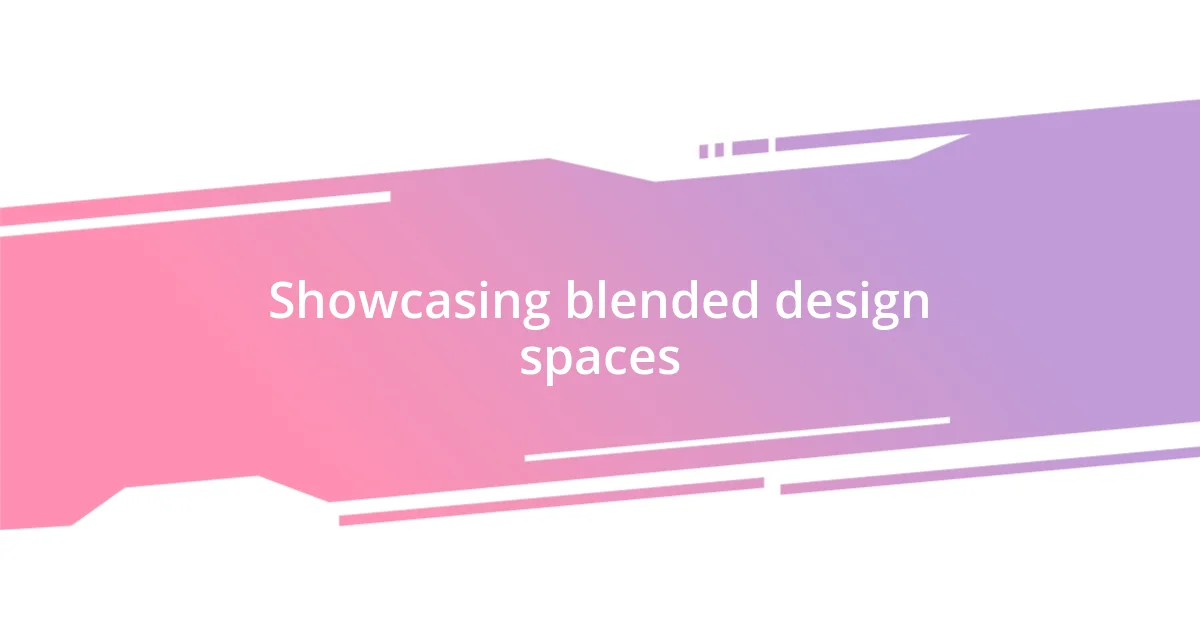
Showcasing blended design spaces

Showcasing blended design spaces
When I created my home’s entryway, I embraced the challenge of showcasing a blend of traditional and modern elements. I placed a sleek, modern console table against a wall adorned with classic wainscoting. The juxtaposition was stunning; it told a story of past elegance meeting contemporary simplicity. Have you ever stepped into a space that felt like a visual conversation? That’s what I aimed to create—a warm invitation that sets the tone for the rest of the home.
I’ve also experimented with lighting to accentuate blended design spaces. Picture this: a striking mid-century chandelier paired with vintage sconces that softly glow on either side of an antique mirror. The interplay of old and new techniques can transform how a room feels, evoking nostalgia while offering a modern flair. It’s in these details that I find joy; they remind me of the dance between eras and styles, don’t you think?
Layering art is another fantastic way I’ve showcased blended design aesthetics. In my living room, I hung a contemporary abstract painting among family heirloom portraits. The vivid colors and shapes of the painting breathed new life into the classic frames surrounding it. This was not just about decoration; it sparked conversations about memories and modernity. How can we use art to bridge generations? In my experience, the emotional connection we create through art can anchor our spaces, allowing them to reflect our journey through time.












